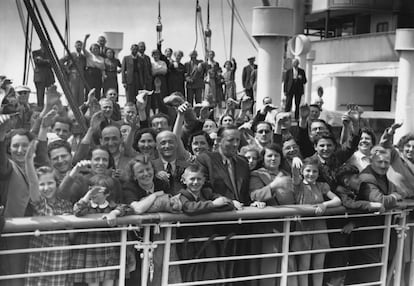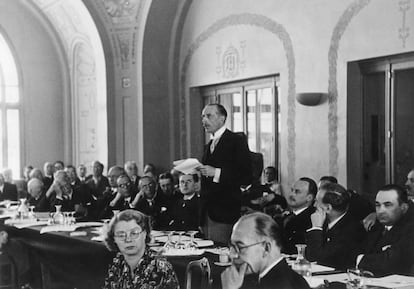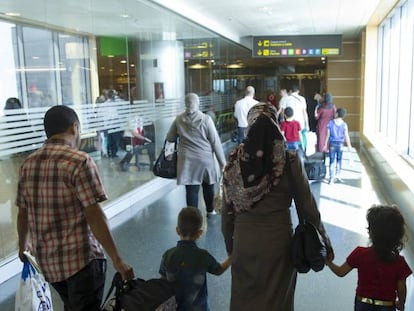When the world shut its doors to the Jews
UN papers highlight parallels between failure to help those fleeing Nazis and Syria crisis today

In this year’s biopic of Stefan Zweig – the Austrian writer who found refuge in the United States – the author spends a lot of time anguishing about the fate of Jewish friends and colleagues trying to flee Nazi-controlled Europe. “There are no visas for the Jews anymore,” says Zweig at one point.

The Allies’ decision to close their borders to Jews during World War II is still a sensitive subject, and new files held by the United Nations that have just been released by the London-based Wiener Library for the Study of the Holocaust and Genocide show that the United States, Russia, and Great Britain knew as early as December 1942 about Germany’s operations to liquidate European Jewry in the wake of the invasion of the Soviet Union in June 1941.
Arguments ISIS activists could infiltrate refugees fleeing war in Syria have been heard in recent years
Historian Paul R. Bartrop, director of the Center for Judaic, Holocaust and Genocide Studies at the University of Florida Gulf Coast, is working on a major study of the Allies’ response to the Final Solution, as the Nazi plan to murder all Jewish people is known. The project focuses on the Evián Conference in 1938, where delegates from 32 countries discussed the Jewish refugee problem and the plight of the increasing numbers of Jewish refugees fleeing persecution by Nazi Germany – a situation that has many parallels to the response to the war in Syria.
“Governments around the world faced a very similar crisis to the one that we are living through today,” says Bartrop, going on to cite questions posed at the time: “Should [those governments] open their doors to anybody with refugee status? Should they impose quotas, and if so, how to decide on how many to let in? Should refugees be let in regardless of the economic situation of the countries receiving them? Should they accept refugees with ethnic backgrounds and religions different from the majority of people in the country of destination? Then, as now, these were the questions being asked, and an urgent reply was required.”
Bartrop’s will be the first major study of the Evián Conference, which was called at the behest of the United States in the French spa town in July 1938. The Axis nations of Germany, Italy and Japan refused to attend, as did the Soviet Union. Even Poland and Romania only sent observers. Germany’s race laws were already prompting large numbers of Germany’s 600,000-strong Jewish community to leave.

The conference was a failure. Chaim Weizmann, who would become the first president of Israel, summed up the conference: “The world seems to be divided into two parts – those places where the Jews cannot live and those where they cannot enter.”
The St. Louis, a ship that left Hamburg for Cuba in May 1938 with 937 people aboard, most of them Jews, became a powerful symbol: it was refused permission to dock in Cuba, the United States and Canada and eventually returned to Europe. Most aboard went to countries later invaded by Germany, and some 278 were sent to death camps.
When war broke out in September 1939, it became even harder for refugees to find a haven. “With Europe at war, many countries felt they should close their borders to prevent fifth columnists infiltrating refugee groups,” says Bartop. Arguments that ISIS activists could infiltrate groups of refugees fleeing war in Syria have been heard in recent years.
The Allies’ efforts were focused on defeating the enemy, there was no room for anything else
Dan Plesch, director of the Centre for International Studies and Diplomacy at the University of London
The UN’s War Crimes Commission also shows that even when the Allies knew about the scale at which Jews were being killed by Germany in Eastern Europe, no help was forthcoming. “These documents show for the first time that all the resistance movements in occupied Europe knew what was happening, when the Nazis were still running the extermination camps,” says historian Dan Plesch, director of the Centre for International Studies and Diplomacy at the University of London, and who has studied recently released documents and that he has written about in Human Rights After Hitler: The Lost History of Prosecuting Axis War Crimes.
French says that by 1942, following the Wansee Conference in January of that year in Berlin at which senior German officials outlined the practical details of the Final Solution, the Allies, who now included the Soviet Union, knew about the killing. “At the latest, the fate of the Jews was known by the entire world by December 17, 1942, when the Allies made a joint statement,” says Ben Barkow, director of the Wiener Library. “That statement reaffirmed a resolution to guarantee that those responsible for those crimes would be judged and that is why the UN’s War Crimes Commission was set up.”
These documents show for the first time that resistance movements in occupied Europe knew what was happening
Plesch says that part of the reason the Allies did nothing to help the millions of Jews facing extermination in Europe was antisemitism, and that the media tended to play down atrocity stories emerging from occupied Europe because they had been heard during World War I. “At the same time, the Allies’ efforts were focused on defeating the enemy,” he says. “There was no room for anything else.”
English version by Nick Lyne.
Tu suscripción se está usando en otro dispositivo
¿Quieres añadir otro usuario a tu suscripción?
Si continúas leyendo en este dispositivo, no se podrá leer en el otro.
FlechaTu suscripción se está usando en otro dispositivo y solo puedes acceder a EL PAÍS desde un dispositivo a la vez.
Si quieres compartir tu cuenta, cambia tu suscripción a la modalidad Premium, así podrás añadir otro usuario. Cada uno accederá con su propia cuenta de email, lo que os permitirá personalizar vuestra experiencia en EL PAÍS.
¿Tienes una suscripción de empresa? Accede aquí para contratar más cuentas.
En el caso de no saber quién está usando tu cuenta, te recomendamos cambiar tu contraseña aquí.
Si decides continuar compartiendo tu cuenta, este mensaje se mostrará en tu dispositivo y en el de la otra persona que está usando tu cuenta de forma indefinida, afectando a tu experiencia de lectura. Puedes consultar aquí los términos y condiciones de la suscripción digital.
More information
Últimas noticias
Maduro pleads not guilty before the federal court in New York: ‘I am still the president of Venezuela’
A new test can detect Alzheimer’s from a finger prick
UN team enters Sudanese city of El Fasher after paramilitary massacre: ‘It’s like a ghost town’
A recipe for resistance: Indigenous peoples politicize their struggles from the kitchen
Most viewed
- Gilles Lipovetsky: ‘If you want to live better and fall in love, take Prozac, don’t look to philosophy’
- Alain Aspect, Nobel laureate in physics: ‘Einstein was so smart that he would have had to recognize quantum entanglement’
- Maduro’s downfall puts China’s relationship with Venezuela to the test
- Why oil has been at the center of Venezuela-US conflicts for decades
- Alvin Hellerstein, a 92-year-old judge appointed by Bill Clinton, to preside over Maduro’s trial in New York










































